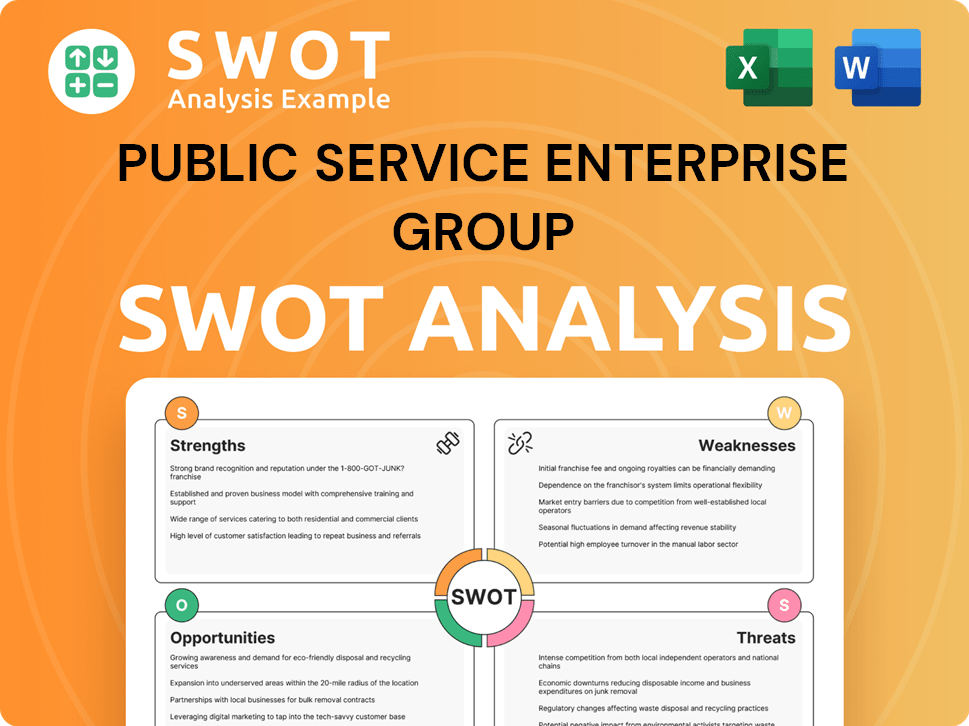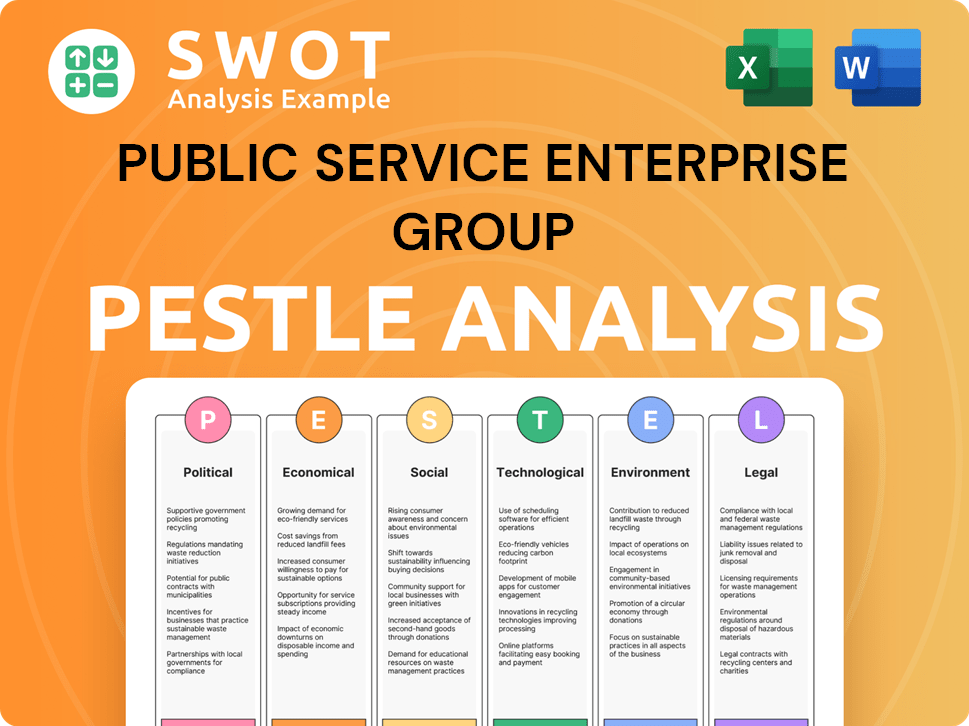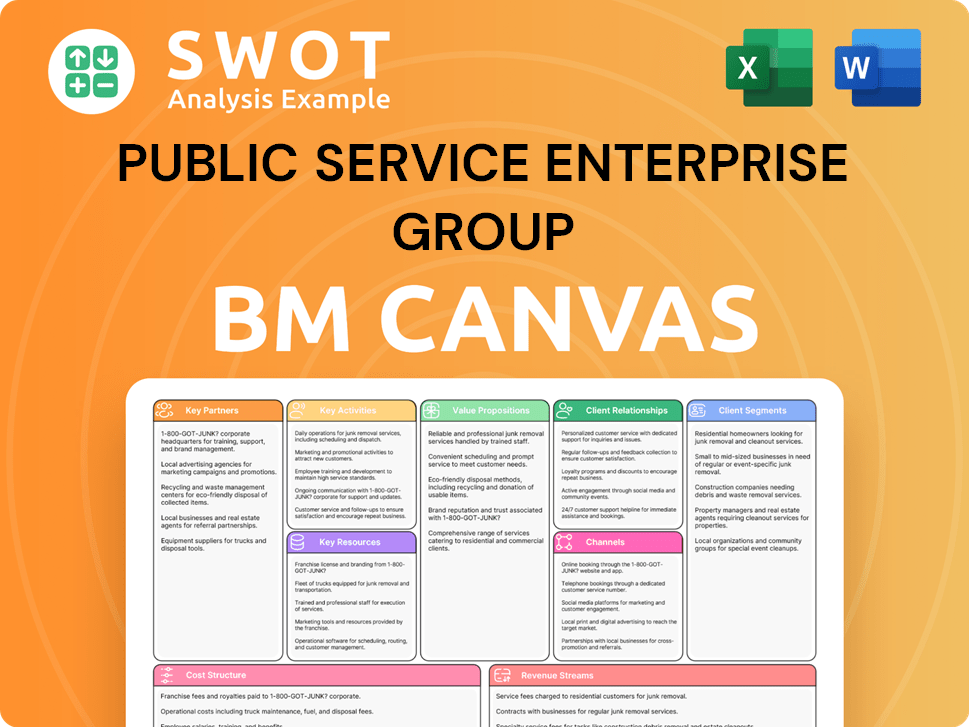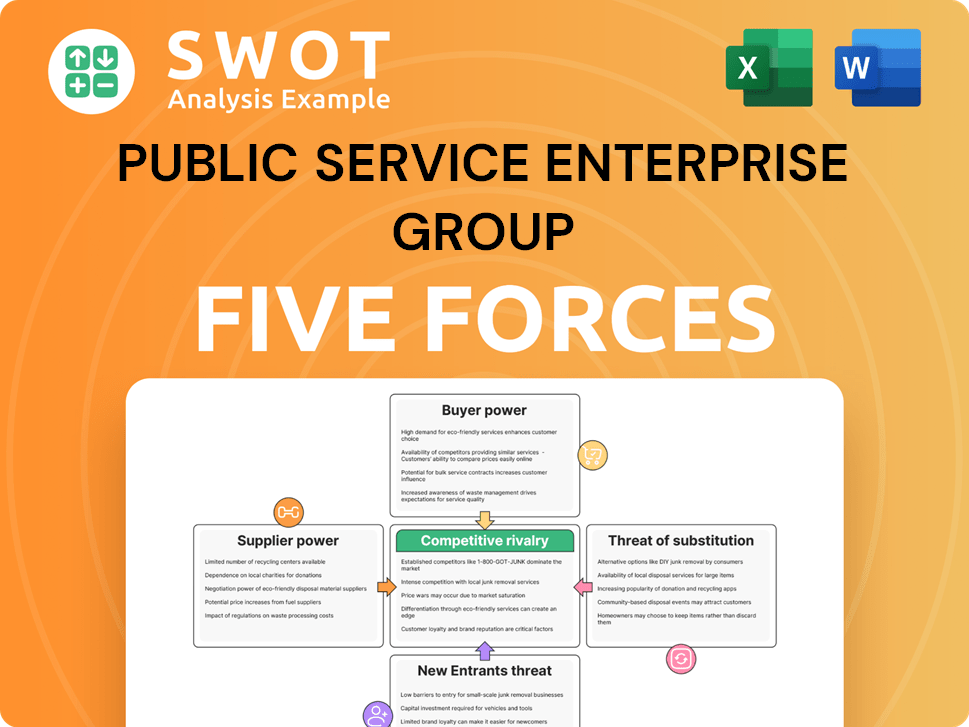Public Service Enterprise Group Bundle
How Does Public Service Enterprise Group Navigate the Energy Sector's Competitive Waters?
In an era defined by decarbonization and grid modernization, understanding the Public Service Enterprise Group SWOT Analysis is crucial. PSEG, a key player in this transformation, is strategically focusing on regulated utility operations and infrastructure investments. This approach reflects a broader industry trend, promising stable returns amidst the energy transition, making it a compelling subject for market analysis.

This exploration delves into the Public Service Enterprise Group's competitive landscape, examining its position within the energy sector. We'll dissect its primary rivals and competitive advantages, analyzing its strategic initiatives and financial performance compared to its peers. Understanding the company's response to market changes, including its renewable energy projects and regulatory environment, is key to grasping its future in the energy market. This deep dive will also address questions like "Who are PSEG's main competitors?" and "What is PSEG's market share in New Jersey?"
Where Does Public Service Enterprise Group’ Stand in the Current Market?
PSEG maintains a strong market position within the U.S. energy sector, largely due to its regulated utility operations. Public Service Electric & Gas Co. (PSE&G), the primary utility, serves a substantial customer base in New Jersey. The regulated nature of this segment provides stable and predictable earnings, forming a solid foundation for PSEG's financial performance.
The company's core operations include electricity and natural gas transmission and distribution through PSE&G, alongside power generation from PSEG Power. This diversified approach, combining regulated utilities with power generation, provides a balanced business model. PSEG's strategic focus has shifted towards its regulated utility business and clean energy investments, as demonstrated by its long-term capital investment plan.
As of Q1 2025, PSEG reported robust financial results, with regulated utility operations contributing significantly to its earnings. This financial health is supported by a commitment to sustainable growth and strategic initiatives focused on grid modernization and renewable energy integration. For a deeper understanding of PSEG's financial structure, consider exploring the Revenue Streams & Business Model of Public Service Enterprise Group.
PSE&G serves approximately 2.3 million electric customers and 1.9 million gas customers in New Jersey. This large customer base gives PSEG a dominant market share within the state. The regulated nature of the utility business ensures a stable customer base and predictable revenue streams.
While primarily focused on New Jersey, PSEG's power generation assets extend beyond the state. The company's strategic investments in grid modernization and renewable energy projects support its long-term growth. PSEG's focus is on the Mid-Atlantic region, where PSE&G's infrastructure is critical for energy reliability.
PSEG demonstrates strong financial health, supported by its regulated earnings and strategic investments. The company's commitment to sustainable growth aligns with industry trends. The company has a long-term capital investment plan of $18.5 billion for 2024-2028, primarily directed towards PSE&G's infrastructure and clean energy programs.
PSEG is focused on grid modernization, energy efficiency, and renewable energy integration. These initiatives support its market standing and align with broader industry trends. The company is investing heavily in its infrastructure and clean energy programs.
PSEG's competitive advantages include its regulated utility business, which provides stable earnings. Its strategic investments in grid modernization and renewable energy projects enhance its market position. The company's focus on the Mid-Atlantic region, where PSE&G provides critical infrastructure, is also a key strength.
- Strong Market Position: Dominant in New Jersey with a significant customer base.
- Financial Stability: Supported by regulated earnings and strategic investments.
- Strategic Focus: Grid modernization, energy efficiency, and renewable energy integration.
- Geographic Advantage: Critical infrastructure in the Mid-Atlantic region.
Public Service Enterprise Group SWOT Analysis
- Complete SWOT Breakdown
- Fully Customizable
- Editable in Excel & Word
- Professional Formatting
- Investor-Ready Format

Who Are the Main Competitors Challenging Public Service Enterprise Group?
The competitive landscape for Public Service Enterprise Group (PSEG) is multifaceted, encompassing both direct and indirect competitors across its regulated utility and power generation segments. Understanding this landscape is crucial for a comprehensive market analysis, especially when assessing PSEG's strategic positioning and future prospects within the energy sector. The company faces challenges and opportunities from a variety of players, ranging from established utilities to emerging renewable energy providers.
PSEG's competitive environment is dynamic, influenced by regulatory frameworks, technological advancements, and evolving consumer preferences. The company's ability to adapt to these changes and effectively compete will determine its long-term success. This competitive analysis is essential for investors, analysts, and stakeholders seeking to understand PSEG's market position and potential for growth.
In the regulated utility space, PSE&G, a subsidiary of PSEG, holds a monopoly in its service territory. However, it still faces indirect competition for capital investment and regulatory support. Moreover, distributed energy resources pose a growing challenge. Major diversified energy companies operating in adjacent regions, such as Exelon Corporation and Con Edison, are significant peers.
Exelon is a major competitor due to its substantial regulated utility operations and competitive power generation capabilities. Its scale and diversified portfolio across multiple states make it a formidable player. Exelon's financial performance and strategic initiatives directly impact the competitive dynamics within the energy market.
Con Edison, serving New York City and Westchester County, is another large, established utility. It competes with PSEG for investment capital and talent in the Northeast energy market. Con Edison's strategic moves and financial results influence the competitive landscape.
Vistra Corp. is a leading integrated retail electricity and power generation company. It has a diverse fleet, including natural gas, coal, nuclear, and battery storage. Vistra's competitive strategies and market share are key factors in the energy sector.
NRG Energy is a significant player with a substantial generation portfolio and retail electricity operations. The company's competitive positioning and financial performance affect the overall market dynamics. NRG's strategic initiatives are crucial for understanding the competitive landscape.
NextEra Energy Resources, a subsidiary of NextEra Energy, is particularly strong in renewable energy development and operations. It poses a competitive challenge in the rapidly growing clean energy sector. NextEra's focus on renewables directly impacts PSEG's strategic initiatives.
PSEG Power competes with numerous independent power producers (IPPs) in wholesale energy markets. These IPPs, along with the generation arms of other utilities, influence the competitive intensity. The financial performance of IPPs directly affects PSEG's market position.
In the power generation segment, PSEG Power competes in wholesale energy markets. Key competitors include Vistra Corp., NRG Energy, and NextEra Energy Resources. These companies, along with other IPPs, influence the competitive dynamics. The rise of distributed generation, such as solar developers and energy storage providers, presents a growing indirect challenge. Mergers and alliances also reshape the competitive landscape.
High-profile 'battles' often manifest in competitive bidding for renewable energy projects and grid modernization initiatives. Strategic initiatives and regulatory frameworks significantly influence the competitive landscape. PSEG's response to market changes and its strategic initiatives are critical for its future.
- Renewable Energy Projects: PSEG actively participates in competitive bidding for renewable energy projects. The company's success in these bids directly impacts its market share and growth.
- Grid Modernization: Grid modernization initiatives are another arena of competition. Investments in smart grid technologies and infrastructure upgrades are crucial for maintaining a competitive edge.
- Regulatory Frameworks: The regulatory environment significantly affects the competitive dynamics. PSEG must navigate and influence regulatory changes to maintain its competitive position.
- Distributed Generation: The rise of distributed generation, including solar and energy storage, presents a growing indirect challenge. These alternatives to traditional grid-supplied power impact PSEG's market share.
- Mergers and Alliances: Utility consolidations and partnerships for large-scale infrastructure projects reshape the competitive landscape. These developments can create larger, more formidable rivals or new collaborative opportunities.
Public Service Enterprise Group PESTLE Analysis
- Covers All 6 PESTLE Categories
- No Research Needed – Save Hours of Work
- Built by Experts, Trusted by Consultants
- Instant Download, Ready to Use
- 100% Editable, Fully Customizable

What Gives Public Service Enterprise Group a Competitive Edge Over Its Rivals?
PSEG's competitive advantages are built on its strategic assets, operational expertise, and commitment to sustainability. The company's regulated utility, Public Service Electric & Gas Co. (PSE&G), provides a stable revenue stream and a significant barrier to entry. This is supported by state-approved rates and an extensive transmission and distribution infrastructure across New Jersey.
The company is investing heavily in grid modernization and resiliency, with an expected $18.5 billion investment from 2024-2028. PSEG Power's diverse generation fleet, including nuclear power plants, offers reliable, emission-free power. PSEG's financial health and access to capital markets support large-scale infrastructure projects and strategic initiatives.
PSEG's strong relationships with regulators and its deep understanding of the regulatory environment in New Jersey are invaluable, facilitating the timely approval of rate cases and infrastructure projects. PSEG is increasingly leveraging its regulated utility strength to drive clean energy initiatives and grid modernization, aligning with public policy and consumer preferences. For more insights into the company's ownership structure, you can explore Owners & Shareholders of Public Service Enterprise Group.
PSEG's ownership and operation of PSE&G is a key advantage. The extensive transmission and distribution infrastructure across New Jersey is a critical asset, difficult and costly to replicate. Ongoing capital investments in grid modernization enhance reliability and enable the integration of new energy technologies.
PSEG Power's diverse and largely decarbonized generation fleet, including nuclear power, provides reliable, emission-free power. The company's strong financial health and access to capital markets enable it to fund large-scale infrastructure projects. PSEG's long-standing relationships with regulators are invaluable.
PSEG is strategically shifting towards a cleaner energy portfolio, including investments in offshore wind and solar. This positions the company favorably for the future. The company's focus on clean energy initiatives and grid modernization aligns with public policy and consumer preferences.
PSEG's strong financial health enables it to invest in advanced technologies. This financial strength allows the company to enhance operational efficiencies. PSEG can maintain a high level of customer service.
PSEG's competitive advantages include its regulated utility status, extensive infrastructure, and diverse generation fleet. The company benefits from its strong financial position and relationships with regulators. These advantages are crucial in the Energy Sector and the overall Competitive Landscape.
- Regulated Utility Model: Provides stable, predictable cash flows.
- Extensive Infrastructure: Difficult and costly for competitors to replicate.
- Clean Energy Initiatives: Aligns with market trends and public policy.
- Financial Strength: Supports large-scale investments and strategic moves.
Public Service Enterprise Group Business Model Canvas
- Complete 9-Block Business Model Canvas
- Effortlessly Communicate Your Business Strategy
- Investor-Ready BMC Format
- 100% Editable and Customizable
- Clear and Structured Layout

What Industry Trends Are Reshaping Public Service Enterprise Group’s Competitive Landscape?
The Energy Sector is currently undergoing significant transformations, driven by the push for decarbonization, the rise of distributed energy resources, and the need for grid modernization. These trends create both challenges and opportunities for companies like Public Service Enterprise Group (PSEG). Understanding the Competitive Landscape requires a deep dive into these dynamics, assessing how PSEG and its competitors are positioned to adapt and thrive.
PSEG's position is influenced by its regulated utility business, PSE&G, and its power generation assets. The company faces risks from increasing regulatory scrutiny, competition from non-traditional energy providers, and the potential for declining demand due to energy efficiency improvements. However, PSEG is also well-positioned to capitalize on the growth in clean energy infrastructure and grid modernization. The future outlook for PSEG depends on its ability to navigate these challenges and seize the opportunities presented by the evolving energy market.
The energy sector is seeing a strong push toward decarbonization, with increasing investments in renewable energy sources like solar and wind. Grid modernization is crucial, focusing on smart grid functionalities and enhancing energy resilience. Digitization and the integration of energy storage technologies are also key trends reshaping the industry landscape.
PSEG faces challenges including increased regulatory scrutiny on utility rates and the risk of declining demand due to energy efficiency. Competition from new market entrants focused on renewable energy and advanced grid solutions is intensifying. The company must also manage the transition from fossil fuels and adapt to evolving customer expectations.
Significant growth opportunities exist for PSEG in clean energy infrastructure, especially in offshore wind development, and through investments in grid modernization. Strategic partnerships and innovation in technology can unlock new revenue streams. PSEG can leverage its regulated utility segment to drive growth in these areas.
PSEG is deploying strategies focused on sustainable infrastructure investment, clean energy transition, and operational excellence. The company is also focused on delivering reliable, affordable, and cleaner energy solutions to its customers. These initiatives are crucial for maintaining a competitive edge.
PSEG's competitive advantages include its regulated utility business, investments in renewable energy, and strategic focus on grid modernization. Key competitors in the Energy Sector include NextEra Energy and other utility companies. The competitive landscape is also shaped by the regulatory environment and customer demand. For a deeper dive into PSEG's market approach, consider reading about the Marketing Strategy of Public Service Enterprise Group.
- Market Analysis: Evaluating market share, customer base, and growth potential.
- Financial Performance: Comparing financial metrics, such as revenue and profitability, with peers. In 2024, PSEG reported revenues of approximately $12.4 billion.
- Strategic Initiatives: Assessing the impact of acquisitions, renewable energy projects, and technological advancements.
- Regulatory Environment: Analyzing the impact of regulations on utility rates and operations.
Public Service Enterprise Group Porter's Five Forces Analysis
- Covers All 5 Competitive Forces in Detail
- Structured for Consultants, Students, and Founders
- 100% Editable in Microsoft Word & Excel
- Instant Digital Download – Use Immediately
- Compatible with Mac & PC – Fully Unlocked

Related Blogs
- What are Mission Vision & Core Values of Public Service Enterprise Group Company?
- What is Growth Strategy and Future Prospects of Public Service Enterprise Group Company?
- How Does Public Service Enterprise Group Company Work?
- What is Sales and Marketing Strategy of Public Service Enterprise Group Company?
- What is Brief History of Public Service Enterprise Group Company?
- Who Owns Public Service Enterprise Group Company?
- What is Customer Demographics and Target Market of Public Service Enterprise Group Company?
Disclaimer
All information, articles, and product details provided on this website are for general informational and educational purposes only. We do not claim any ownership over, nor do we intend to infringe upon, any trademarks, copyrights, logos, brand names, or other intellectual property mentioned or depicted on this site. Such intellectual property remains the property of its respective owners, and any references here are made solely for identification or informational purposes, without implying any affiliation, endorsement, or partnership.
We make no representations or warranties, express or implied, regarding the accuracy, completeness, or suitability of any content or products presented. Nothing on this website should be construed as legal, tax, investment, financial, medical, or other professional advice. In addition, no part of this site—including articles or product references—constitutes a solicitation, recommendation, endorsement, advertisement, or offer to buy or sell any securities, franchises, or other financial instruments, particularly in jurisdictions where such activity would be unlawful.
All content is of a general nature and may not address the specific circumstances of any individual or entity. It is not a substitute for professional advice or services. Any actions you take based on the information provided here are strictly at your own risk. You accept full responsibility for any decisions or outcomes arising from your use of this website and agree to release us from any liability in connection with your use of, or reliance upon, the content or products found herein.